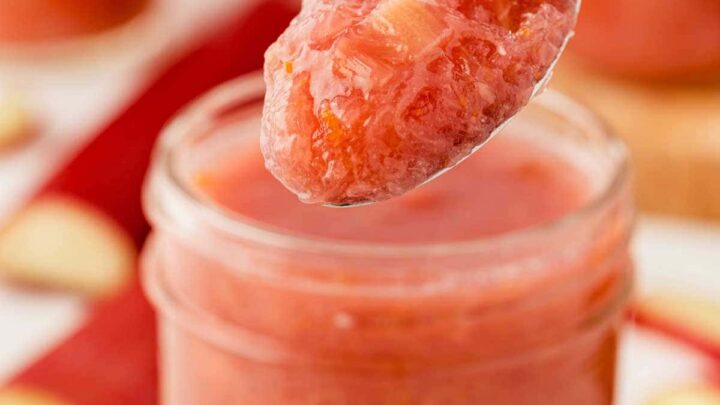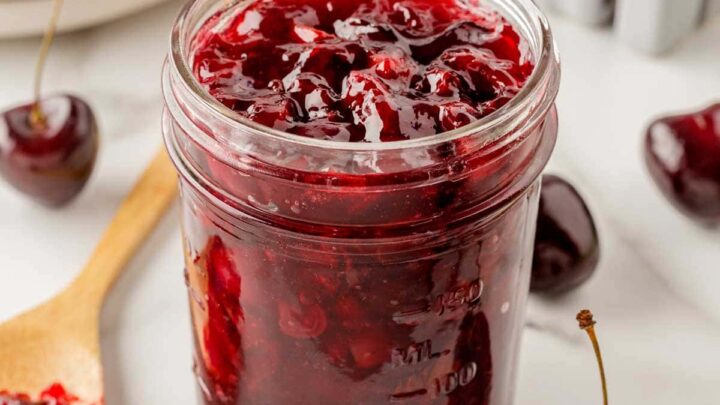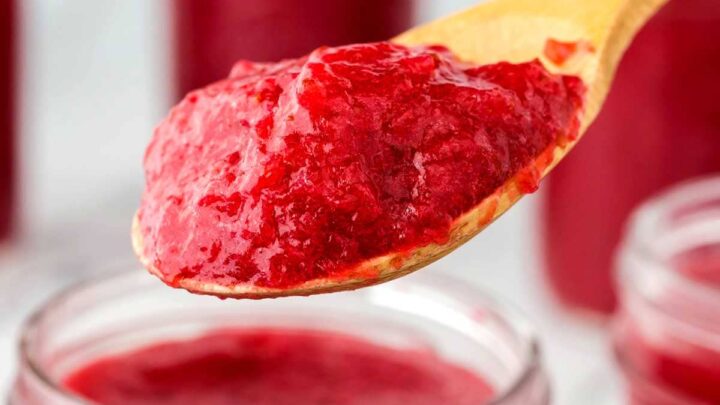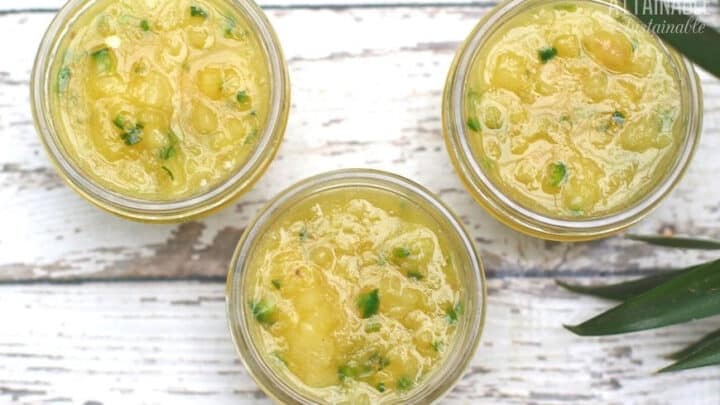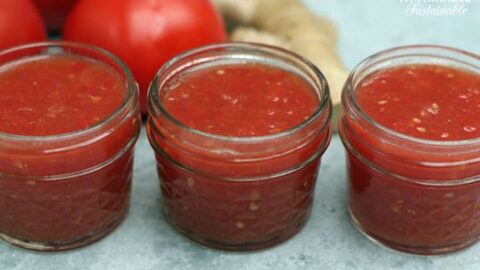Canning jam and jelly at home is one of the easiest ways to get started with home canning. While the ingredients will vary depending on the recipe, the process itself remains the same.
If you’re really new to canning, you should start by reading this post about canning equipment.
Originally published September 2020; this post has been updated.
First and foremost, know that you should not deviate from a safe canning recipe. Adding or subtracting ingredients can alter the pH of the finished product. Follow the recipe as written.
Canning Jam & Jelly, Step-by-Step Guide
No matter what recipe you choose, the process for canning jam and jelly is generally the same. The good news? It’s not difficult!
5 Easy Steps to Transform Your Pantry!
Ready to switch from store bought to homemade? Let me help you make some changes! Grab my FREE five-part guide to getting started.
Water bath canning is the method of choice for jam and jelly recipes, so it’s an easy food preservation project for those new to home canning.
1. Prepare the Fruit
This is the most time consuming step. If you’re making jelly, you’ll need to extract the fruit juice. For jam, you’ll peel and seed if necessary (as with stone fruit) and then mash the fruit. You can do this by hand or with a food processor. [Read about the difference between jam and jelly.]
Choose fully ripe fruit that is free of blemishes. With a caveat. You don’t want to use fruit that’s close to spoiling, but cosmetic issues like bruising and scab can safely be cut away, allowing you to use the remainder of the ripe fruit.
Opting for using culls (the second-quality fruit that farmers often sell for a fraction of the price) is a great way to cut costs. You don’t need pretty fruit to mash into jam or jelly!
2. Start Heating Water in the Canner
Almost all jams and jellies can be processed using a water bath. If you’re using a standard canner that holds a large volume of water, it takes awhile to bring it to a boil.
Get it heating while you continue the process of making your jam or jelly. Fill the canner about halfway with water for pint or half-pint jars, slightly more for pint jars.
3. Sterilize the Jars — Maybe
If the jam or jelly recipe you’re using requires a processing time of less than ten minutes, you’ll need to sterilize the jars. Do this by submerging the jars in boiling water for ten minutes.
If the recipe calls for a processing time of ten minutes or more, you don’t need to sterilize. The jars will be sterilized during the processing time. You will, of course, want to wash the jars well before filling them!
Once washed, place empty jars in the canner while it heats. This brings the temperature of the jars up, so that when you add hot jam or jelly, they jars are less likely to crack due to temperature change.
The Handcrafted Pantry

Ready to DIY your pantry with more wholesome ingredients? Check out my ebook, The Handcrafted Pantry! Filled with delicious recipes for some of your favorite condiments, snacks, and toppings, it’s the guide you need to start skipping packaged products and embrace homemade.
4. Cook the Fruit
Follow the individual recipe to make the jam or jelly. This often means adding sugar, lemon juice, and pectin to the prepared fruit and bringing it to a boil, but the ingredients will vary from recipe to recipe.
Some jam and jelly recipes are made without the use of added pectin. This process can take quite a lot longer as you cook the fruit down and await gel formation.
5. Transfer Fruit Mixture to Jars
Ladle the hot fruit into canning jars. Jam and jelly can be safely canned in 1/4-pint, 1/2-pint, or pint-sized jars.
A canning funnel is a lifesaver for reducing spills.
6. Know Your Headspace When Canning Jam & Jelly
Headspace is the distance from the top of the jam to the rim of the jar. Some canning recipes require more head space than others. Follow the guidelines in your recipe.
7. Wipe the Rims
Use a damp cloth to carefully clean the rim of each jar. Residue left on the jar rim can interfere with proper sealing when canning jam and jelly.
8. Place the Lids and Rings on the Jars
Set a new lid (sometimes called a flat) on each clean jar rim. Read about why you should never reuse canning lids here. Screw a band onto the jar finger tight.
What is finger tight? You want the ring to fit snugly, but don’t crank it on.
9. Process the Jars
Pots dedicated to canning have a rack inside that will keep the jars from sitting on the bottom. If you’re making a small batch of jam in a large stock pot, be sure to use a rack of some sort to keep the jars up. You can make one of your own using extra canning rings.
Water in the canner should come to a rolling boil before you add the jars.
Use a jar lifter (a must for canning!) to lift the filled jars into the boiling water bath canner one at a time.
Make sure that the jars are completely submerged. There should be 1″-2″ of water above the top of the jars. It’s a good idea to have a kettle with hot water on standby in case you need to top it off once the jars are in place.
Adding jars to the water canner will lower the temperature of the water. Return the water to a boil, then start the timer to mark the processing time.
10. Remove the Jars from the Canner
Again using the jar lifters, remove each jar from the canner and set on a towel-covered countertop. Leave the jars undisturbed until they cool thoroughly.
You will likely hear the sound of the lids sealing with a little “tink!” as they cool. It’s a home canner’s favorite noise!
11. Check the Seals
One the jars have cooled completely, check the lids to make sure they’ve sealed. Do this by pressing down in the center of each lid. Do not touch the lids when the jars are still hot, as this can cause a false seal.
The flat lid should feel solid. If it flexes up and down, it did not seal properly and the jar is not shelf stable. Place unsealed jars in the refrigerator and use within a month or so.
12. Store Canned Jam and Jelly
Remove the rings from the jars and wash each to remove any sugary residue that could attract ants. Dry and store jars without the rings.
Storing jars with the rings will hold the lid in place, even if a seal fails. Store canned jams and jellies in the pantry for up to a year.
🍅 Safety First!
Canning is an excellent way to preserve food for the pantry, but there are some important safety considerations to keep in mind. The recipes on this site have been made following safe canning procedures by a certified Master Food Preserver.
- Know the difference between water bath canning and pressure canning. Low acid items must be pressure canned for safety.
- Altering ingredients may change the recipe’s pH, posing a safety issue. I highly recommend investing in pH paper to test your products for acidity level when canning. Note: For safe water bath canning, the Hawaii Master Food Preservers suggest a pH of 4.2 or lower in the tropics. In other regions, the recommended pH is 4.6 or lower.
- Use the proper jars and lids. Never reuse lids, with the exception of the Tattler or Harvest Right hard plastic lids that are intended for such a purpose.
- For more on canning equipment, please go here.
- Want to learn more? The National Center for Home Food Preservation is the go-to resource for safe canning information.
Try one of these recipes!
Canning Plums
If you're lucky enough to have an abundance of fresh plums, preserve some for the pantry. This canning recipe is a water bath recipe, perfect for beginning canners.
Pineapple Jam Recipe
This small batch jam recipe for a not-too- sweet jam preserves the flavor of ripe pineapple in a jar.
Easy Pear Butter Recipe for Canning
This spiced pear butter captures the flavor of autumn in a jar. Process the jars in a boiling water bath to make them shelf stable, or simply refrigerate the fruit spread and use it up - or give it as a gift - within a couple of weeks.
Homemade Nectarine Jam Recipe
This fruit-forward nectarine jam is an excellent addition to your pantry! Tasting the flavor of summertime in mid-winter? Winning!
Rhubarb Jam
This lightly spiced rhubarb jam has a hint of ginger and cardamom for a little something different on your morning toast!
Lower Sugar Apricot Preserves
This recipe results in a thick and slightly chunky preserve with the nectar-like flavor of apricots shining through.
Easy Cherry Jam Recipe
Making jam at home is easy and nets a delicious fruit spread. This cherry jam recipe is delicious on toast, as most jam recipes are, but try stirring it into ice cream for a delicious summertime treat!
Easy Orange Jelly for Canning
This sunny and bright orange jelly is a great addition to the pantry. Serve it on toast or use it to baste grilled chicken for a pop of flavor.
Peach Preserve Recipe
Delicious homemade peach preserves is easy to make for the pantry and it's much less expensive than store-bought jam or preserves.
Old Fashioned Pear Preserves
Making ginger pear preserves is a delicious way to capture the flavor of fall in a jar. Keep some in your pantry and wrap some jars for gift giving.
Easy Plum Jam
The old-fashioned flavor of plum jam is one that is hard to find in stores. Making your own is EASY and a great way to preserve the harvest!
Loquat Jam
It's not likely you'll find this delicious jam at grocery stores! Making loquat jam at home allows you to turn this unique fruit into a flavorful fruit spread.
Lemon Marmalade
This easy marmalade recipe can be used like any of your favorite jam recipes as a topping for toast. But this delicious recipe is also great as a glaze for grilled meats or stirred into marinades.
Persimmon Jam
This easy jam recipe turns persimmons into a delicious spiced spread with the flavors of fall. This lower sugar recipe means the flavor of the fruit will shine through!
How to Make Grape Jelly
This quick grape jelly recipe works with fresh grapes or, for a midwinter jelly emergency, let me let you in on a little secret.
Strawberry Rhubarb Jam
Consider making a few batches of this delicious jam so you can give jars of jam as gifts!
Mango Jam
Homemade mango jam brings the flavor of the tropics to your morning toast! A safe recipe for canning by a certified master food preserver.
Raspberry Jam with Apricots & Honey
This homemade raspberry jam has a lower sugar content than some recipes. The addition of fresh apricots gives the finished product a fresh, sunny flavor.
Seedless Tamarillo Jam
This tamarillo jam recipe taste like a berry fruit spread! Also known as tree tomatoes, you'll be surprised at the sweet flavor & how delicious it is on morning toast.
Pineapple Jam with Jalapeño Peppers
Sweet, spicy, and a little sassy, this pineapple jam will brighten up cold winter days after you preserve it.
Jaboticaba Jam
This beautiful pink jam is as delicious as it is pretty! Made from the tropical jaboticaba fruit, it's a treat to savor!
Easy Blueberry Jam Recipe for Canning
Fill your pantry with jars of this delicious blueberry jam with ginger. Spread it on toast for a taste of summertime all year round!
Passion Fruit Jelly
Liliko‘i -- or passion fruit -- has a delicious tropical flavor. Use the juice from this fruit to make a batch of jelly for the pantry.
Easy Homemade Strawberry Jam
This homemade strawberry jam recipe is easy for beginners, sweetened with honey, and you'll be able to savor the goodness of garden fresh berries all year long!
Caramelized Onion Jam with Balsamic Vinegar
Put up a few jars of this yummy caramelized onion jam -- by way of canner or freezer -- to treat your inner allium lover!
Easy Tomato Jam Recipe
This easy tomato jam recipe makes a sweet and savory spread that's a good addition to a BLT or grilled cheese sandwich.
Tangerine Marmalade with Ginger and Vanilla
Less bitter than marmalade made with the peels, this version without the peels is a bit like a tangerine jam.


















